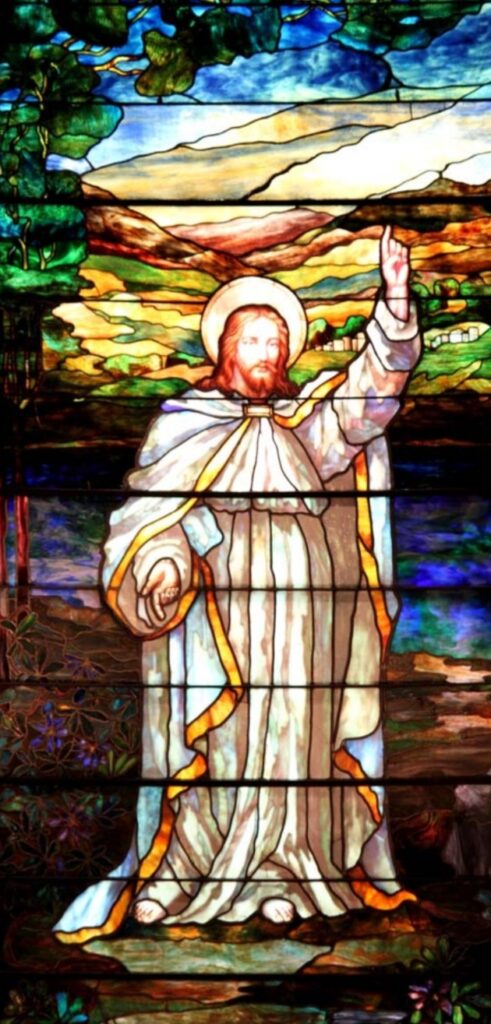
Installed in 1905 by J.B. & Anna Roth in memory of Pastor Henry Harbaugh (1817-1876). Designed by J & Lamb, New York, NY
Jesus of Nazareth, the central figure of Christianity who rose from the dead after being crucified as witnessed to in the Bibleʹs four canonical gospels. Scholars have correlated the biblical Jesus story with non-Christian historical evidence that Jesus was a Galilean Jewish Rabbi regarded as a teacher and healer in Judaea, baptized by John the Baptist, and crucified in Jerusalem on the orders of the Roman Prefect, Pontius Pilate, on the charge of sedition against the Roman Empire. Our Christian tradition teaches that Jesus, the awaited Messiah promised in the Old Testament, born of a virgin, performed miracles, founded the Church, died sacrificially to achieve atonement, rose from the dead, and ascended into heaven, from where he will return to sit in final judgment of all creation. We worship with Jesus as the incarnation of God the Son, the Second Person of the Holy Trinity. Competing descriptions of Jesus through the ages include a self-described Messiah, an itinerant sage, a charismatic healer, the founder of a Jewish restoration movement anticipating a future apocalypse. In the FRC sanctuary he is “the one who has come to us and shared our common lot, conquering sin and death and reconciling the world to God” (UCC Statement of Faith). In the window, Jesus stands in a seamless robe on a path beside a running stream that falls into the Sea of Galilee in the background. Beyond the lake are the hills of Galilee, with the Horns of Hattim, where the Sermon on the Mount is thought to have been preached. Capernaum lies in the curve of the lake shore. Jesus right hand points to the Way, at his feet; his left to the Life of the heavens above; and the great square topaz on his breast is the symbol of the Truth embodied in Himself. During the 1953 sanctuary renovation, reredos were installed above the altar and covered the lower portion of the window and the names of the donors—Norman Reed and George Roth. A brass plate was inscribed with their names and placed near the altar to honor their contribution.
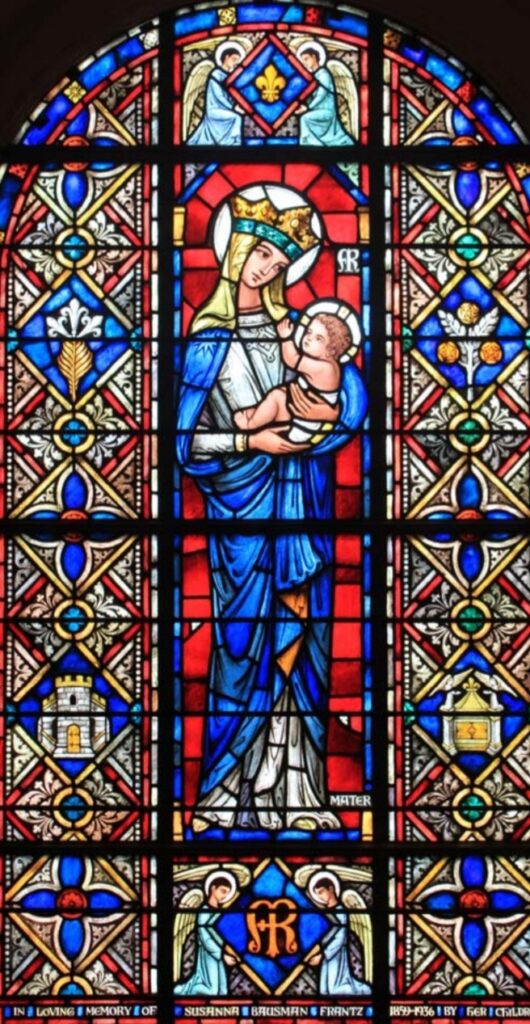
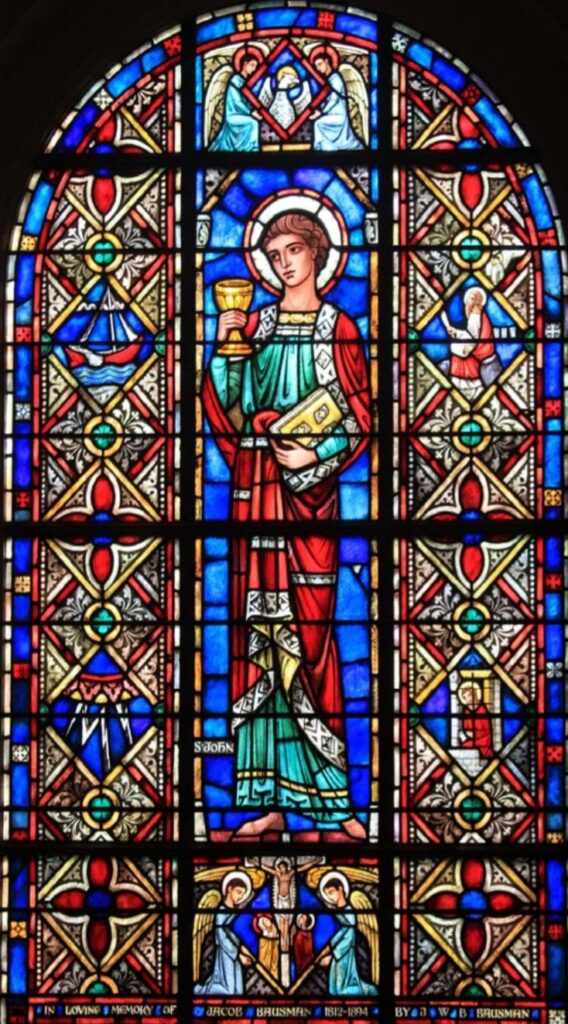
Installed in 1942, in memory of Jacob Bausman. Given by J.W. B. Bausman, and designed by The Studio of Reynolds, Francis and Rohnstock.
John, the son of Zebedee and the brother of James, was a disciple/apostle of Jesus. John and James, and Peter and Andrew, with their father Zebedee, were a family of fisherman. Their call by Jesus to become “fishers of men” is told in Matthew 4:19. John rose in authority in the church, and shortly before the destruction of Jerusalem in 70 CE became the pastor in Ephesus, (in modern day Turkey). He developed close relationships with other churches in Asia Minor and helped build many of their church buildings (as mentioned in Revelation). James was the first of the twelve apostle to die; and John the last. All except John came to violent deaths. While in Ephesus, the Emperor Domitian exiled John to the island of Patmos. On the island, he wrote the book of Revelation, the Gospel of John and I, II and III John. Released by Emperor Trajan, he returned to Ephesus, where he died in 100 CE at the age of 86. The large panel figure of Saint John shows him holding a Chalice in one hand and a book in the other, which signify that he was willing to drink the Cup and follow in Christ’s path as recorded in Matthew 20:22 and that he was a writer of a precious part of the New Testament. Above him seraphs bear an eagle, John’s symbol among the four gospel writers (see page 38). The left lower medallion depicts clouds and lightening, recalling the name Jesus gave to John and his brother, ʺBoanerges,ʺ Sons of Thunder (Mark 3:17). In the medallion above is an empty fishing boat and nets which John left to follow Jesus (Mark 1:19). The lower right medallion shows John in prison on Patmos. The upper right medallion shows John with quill and behind him three scrolls — his Gospel, Epistles, and Revelation. The bottom medallion shows John with Mary at the Cross, a reminder that he was the only disciple who remained with Jesus to the end, and to whom Jesus bequeathed the care of his mother. ʺWoman, behold thy son, Son; behold thy mother.ʺ
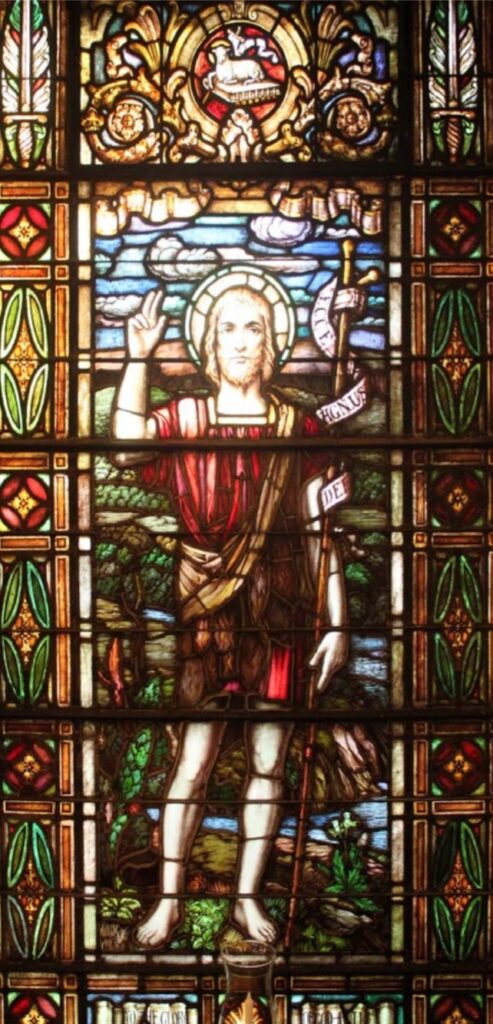
Installed in 1913, by Susan Hull and Emma Bartles, in memory of their parents. Designed by d’Ascenzo Studios, Philadelphia, Pennsylvania.
A prophetic voice, John, born late in Zechariah and Elizabethʹs life, a cousin of Jesus, became an itinerant preacher, ascetic (one dedicated to inner reflection and who practices extreme self-denial) and eventually a major Jewish reformed religious figure who led a movement of baptism renewal at the Jordan River. He is considered a prophet in Christianity, Islam, the Bahai Faith and Mandaeism. John anticipated a messianic figure who would be greater than himself; and in the New Testament he recognizes that Jesus is the one whose coming was foretold. John is also frequently identified with the prophet Elijah. Some of Jesusʹ early followers had been followers of John. His popularity and the revolutionary possibilities of his message lead to his imprisonment, and execution by Herod Antipas as described in Mark 6:14-29 . In the window, John is depicted as an ascetic wearing camel hair, carrying a staff, and a scroll bearing the inscription ʺEcce Agnus Deiʺ —Behold, the Lamb of God; a reference to Jesus. Above him is the “Agnus Dei” a symbol widely used in Christian iconography of Jesus as a lamb holding a standard and banner with a red cross signifying victory. It rests on the lambʹs shoulder and is held in its right foreleg. The lamb is lying atop a book with seven seals hanging from it, a reference to the imagery in the Book of Revelation 5:1-13.
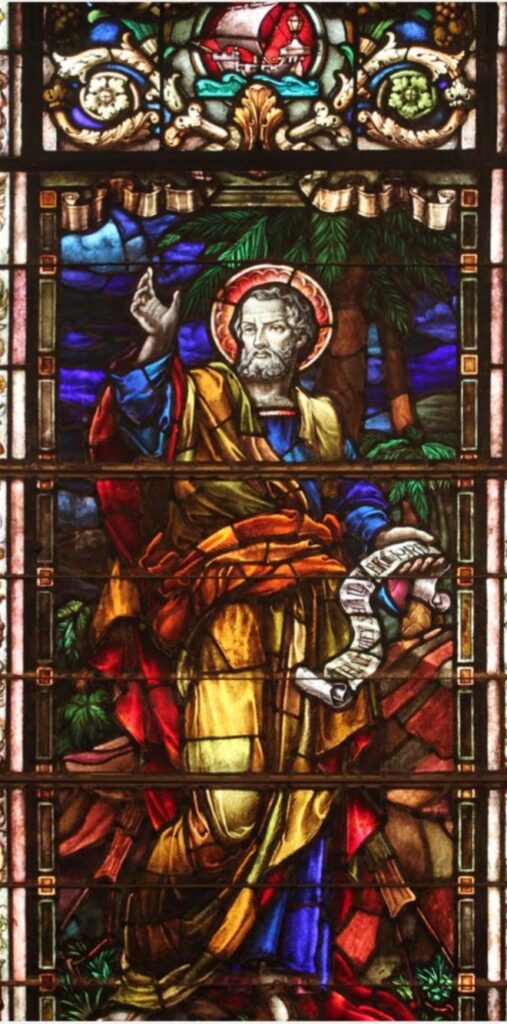
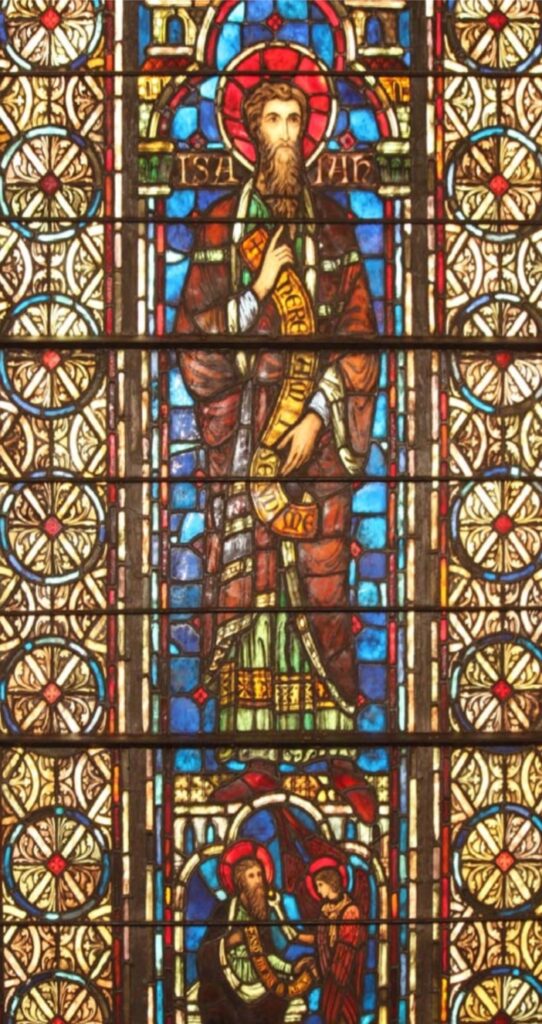
Installed in 1923, to the memory of Harry L. Raub, by Mrs. Harry L. Raub and Family. Designed by The Studios of Reynolds, Francis and Rohnstock.
Reaching back into the early days of modern Judaism, Isaiah exercised the office of prophet for 64 years. He was witness to some of the most turbulent periods of Jerusalemʹs history. His status allowed him to take an active part in the events of this period, and sometimes to guide them. His access to members of the royal family and the palace suggest that he was part of the Jerusalem aristocracy. Isaiah was the most political of the prophets. He was wary of his country making alliances with their neighbors, and favored Godʹs lordship over the world to save them. Living in a time in which both Israel (northern kingdom) and Judah (southern kingdom) were being threatened and finally overrun by their enemies, Isaiah spoke freely as he foretold their eventual exile to Babylonia, a result of their unfaithfulness to God. Chapters 1-39 reflects the prophetʹs time and the approaching destruction of Israel by the Babylonians. Chapters 40-55, and 56-66, written later during the Babylonian exile and afterwards respectively, affirmed that the Lord would see them through their ordeals and beyond. These writings gave Israel, and later the Church, encouragement in down days that they would survive and again receive God’s blessing by the arrival of the Messiah in Isaiah 9, “For to us a child is born, to us a son is given…And he will be called Wonderful Counselor, Mighty God, Everlasting Father, Prince of Peace.” The glass of this window is Antique English Glass similar to that found in old English Cathedrals. The pedella beneath the Prophet portrays the Angel spoken of in the Vision of Isaiah, touching his lips with a purifying live coal of fire held in tongs. And in his hands, Isaiah’s response to God’s call, “Then I heard the voice of the Lord, saying, ‘Whom shall I send, and who will go for Us?’ Then I said, ‘Here am I. Send me!’” (Isaiah 6:6-8).
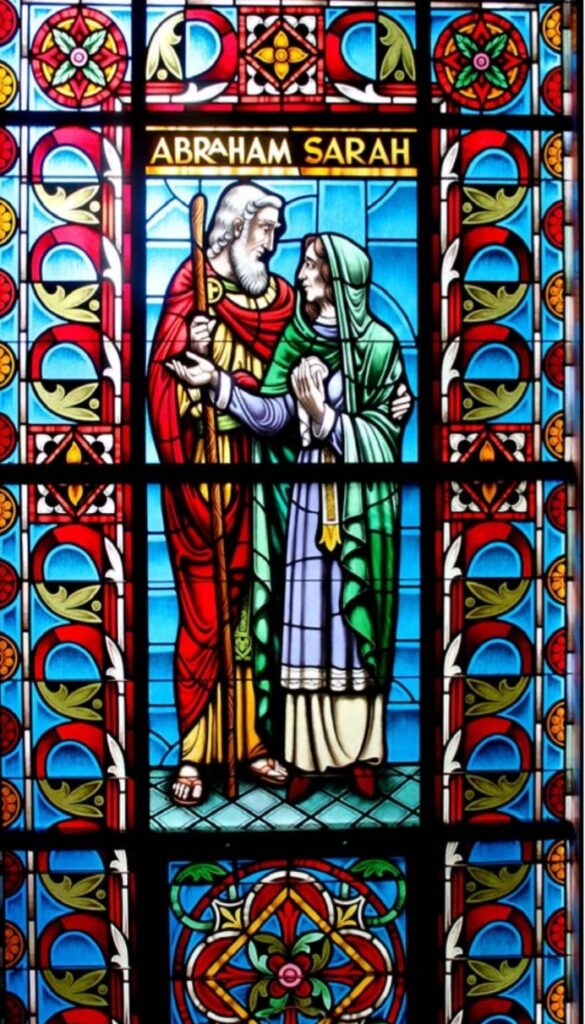
Installed in 1987, by Jacob Frey King, Floyd S & Blanche W. Kline. Mr. King served the congregation as a Trustee. Mr. Kline as a Deacon and Elder, and Mrs. Kline as President of the Women’s Guild. Designed by Willet Stained Glass Studios, Philadelphia, Pennsylvania.
We honor Abraham (Abram), the son of Terah, husband of Sarah and father of Isaac, because he is Israelʹs great patriarch; and for Israel and Christianity, as well as Islam, he is the fore-father of a great host of the faithful. In our series of windows, Sarah represents the Old Testament women of faith as Mary, the mother of Jesus, represents the New Testament women of faith. Reared in Ur in southern Mesopotamia (modern day Persia/Iraq), Abraham and Sarah followed Godʹs lead and moved northward through the Tigris-Euphrates river valley to Haran, a flourishing center in Anatolia (now southern Turkey). Still feeling called by God, they moved southward through Syria into Palestine. Following a short stay in Egypt, they lived out his life in Palestine Thinking Sarah barren, Abraham had a son Ishmael through Sarahʹs servant Hagar; but when Sarah later became pregnant and has a son Isaac, Hagar and her son Ishmael were driven away, presumably to die in the desert. However they lived and eventually become the people we now call the Arabs. Three themes link Abraham with the later tradition: 1) Godʹs promise of innumerable descendants, 2) a home in the land of Canaan and 3) Abrahamʹs faithful response. Godʹs covenant with Abraham is the golden chord linking people of Jewish, Christian and Muslim faith down through the ages to our day. The window image of Abraham and Sarah reminds us that she was willing to go with him wherever he felt called to go; and the ointment jar in her hand may suggest that she was willing to travel lightly!
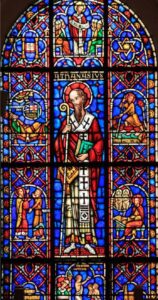
Installed in 1929, in memory of Caroline S. Keiper. Designed by The Studios of Reynolds, Francis and Rohnstock.
The first and greatest of the Five Greek Church Fathers (symbolized by the Eastern Star in the upper right corner), Athanasius was reared in Alexandria, Egypt in a Christian family where the story is told (and rendered in the bottom-center panel) that Bishop Alexander once saw boys imitating the ritual of Christian baptism. He discovered that one of the boys (Athanasius) acted the part of the bishop and ʺbaptizedʺ several of his companions. Alexander recognized the make-believe baptisms as genuine and set Athanasius on course for the priesthood. He became the 20th Bishop of Alexandria in 328 CE. As a deacon and personal secretary of Bishop Alexander, he led the attack at the Council of Nicea (depicted at the top of the window) in 325 CE against the Arian idea that Christ is of a distinct separate substance from the Father. Athanasius is shown arguing with Arius in the left lower panel that Christ had to be true man in order to identify with our sin, and true God in order to cleanse us of it. Together Father and Son were of one substance (“homoousios”) and to this principle and that of the Trinity Athanasius dedicated much of his life and writing. He is depicted on the right at his bench, quill in hand, Father and Son before him, the inspiration of the Holy Spirit flowing from them to parchment, drafting what appears to be a letter to Marcellus of Ancyra (modern day Ankara, Turkey) who did not share Athanasius’ Trinitarian convictions. Were it not for Constantineʹs God inspired vision in a dream (shown upper left), the Roman Emperor would not have made the cross the “sign in which he would conquer” at the Milvian Bridge (upon which he sleeps) nor would he have made Christianity the religion of the empire. But it was Constantine and his successors Constantius and Julian who, hoping to keep peace both in the church and the Empire, sided with the larger Arian movement and forced Athanasius into exile five times during his forty-five year episcopate. Thus his depiction in a boat in the upper right corner fleeing the staff of royal decree. Athanasius is shown in traditional eastern bishopric attire with the shepherd’s staff (a symbol of one who hears Jesus’ call and feeds Jesus’ sheep—John 21:16) and closed stole which represents his being yoked with Christ. The books are his Two Books Against the Heathens: first On the Incarnation; second Against the Heathen. He was equally well known for his work The Life of St. Anthony.
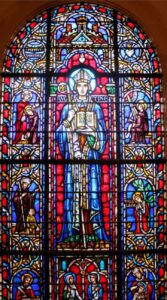
Installed in 1929 and donated by Caroline S. Keiper in memory of her husband, Lanius B. Keiper, the son of John and Nancy Keiper, descendants of the Reformed faith from Holland. Designed by The Studios of Reynolds, Francis and Rohnstock, Boston, Massachusetts.
In the central figure, Augustine (364-430 A.D), the greatest of the Fathers of the Western Church, is depicted as a young man, robed as a bishop, holding the pastoral staff in his right hand, and in his left, the open book. On the book is inscribed the first clause of a typical quotation from his writings, ʺIn Coelo quails est Paterʺ (from the Latin ’Our Father Who Is In Heaven’) Above his head is the flaming heart, symbol of Divine Love. The predella below Saint Augustine shows the youthful Augustine and his mother, Monica, an African woman, seated together on a balcony and reflecting on the after life. The six other small objects are typical incidents from the life of Saint Augustine, In the left at the bottom, he is seated writing his discourse on the Trinity. On the right hand side at the bottom, he is being baptized by Saint Ambrose. In the middle at the left hand side is the legend of Saint Augustine speaking to the child on the seashore. In the middle medallion on the right side is the incident related by Saint Augustine himself in his ʺConfessions” when, in the solitude of his garden he threw himself on the ground beneath the fig tree and heard a child-like voice saying three times, ʺTolle Lege,ʺ or ʺTake and Read.ʺ Looking up and seeing no one he returned to his room, took up the Bible which opened at the thirteenth chapter of the epistle to the Romans. The incident made a deep impression on Saint Augustine. The two symbols at the top of the window are the accepted ones for Saint Augustine. The one on the left represents a light from Heaven shining on the word Veritas, symbolizing his love for Truth. The one on the right, a flaming heart transfixed by two arrows, alludes to the remorse endured by Saint Augustine.
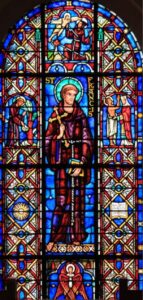
Installed in 1939, in memory of Lanius B. & Caroline B. Keiper. Designed by The Studios of Reynolds, Francis and Rohnstock, Boston, Massachusetts.
Francis of Assisi (1182-1226 A.D.) – who imitated and preached Christ in the Middle Ages. The color scheme and the design of the St. Francis window reflect and recall the glass nearest the chancel. As throughout the scheme a large central figure occupies the main portion of the round topped opening. St. Francis robed as a Franciscan monk bears the cross in his right hand and the book in his left, emblematic of his work as a preacher and a follower of the Gospel. In the grisaille background around him are placed small related subjects and symbols. Three outstanding incidents in his life have been chosen. Beginning with the one at the left, and taking them in order these are: St. Francis renounces his wealth to enter the Church and removes his rich clothing. The priest covers him with a simple garment; St. Francis preaches to the birds, this act being significant of his love for all nature and all created things; St. Francis receives the stigmata ~ the marks of the crucified Christ. A seraph is used at the base of the window to conger the attribute ʺSeraphicʺ applied to him because of the favor in which he was held by Heaven. Two emblems are also used in the background, the sun in reference to his ʺSong of Brother Sun,ʺ and the open book on which are inscribed ʺPoverty, Chastity and Obedienceʺ which refer to his espousal of these three vows.
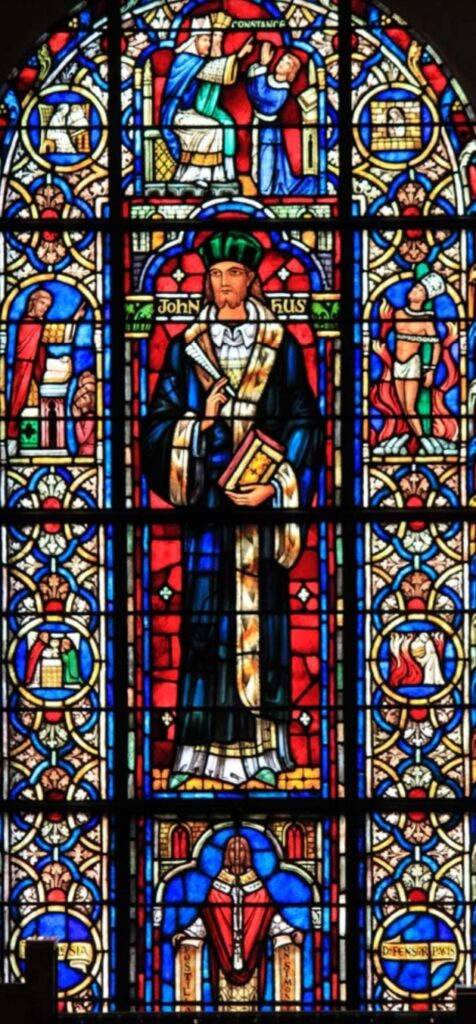
Installed in 1939, in memory of Lanius B. & Caroline B. Keiper. Designed by The Studios of Reynolds, Francis and Rohnstock, Boston, Massachusetts.
John Hus (1373-1415 A.D.) – a pastor among the Bohemian Brethren (later the Moravian Church) whose attempt at reformation preceded Luther’s and lead to his fiery death at the stake for beliefs and practices judged heretical. In the large central figure, John wears an ecclesiastical vestment, the alb, over which is the robe typical of the Magister or university professor. In his hands he holds a book and a pen to suggest his authorship of many significant books including De Ecclesia written to oppose the common position that only ordained clergy comprised the Church. Three important incidents from the life of Hus appear in the larger medallions around the central figure. From left to right these are: Hus preaches to his followers at Bethlehem Chapel, Prague; his martyrdom at the stake at Constance on the Rhine; on trial at Constance for his heresies. Above and below these medallions are symbolized in small circular cortouches other important incidents in his life: Hus administering the Sacrament to the faithful in defiance of an edict by church authorities; burning in the public square of the writings of Hus which took place as he was led to the stake; translating the Bible into the Bohemian language; in prison at Constance awaiting trial. At the base of the window are two other circles enclosing scrolls. One is titled De Ecclesia and the other Defensor Pacis, an important book written by Marsiglio of Padua, a predecessor of John Hus who defined the church as ALL those who believe in Christ. In the medallion at the bottom of the window beneath the large figure, John Hus robed in church vestments and holding two scrolls bearing the names of two of his important works. Upon his death, the Moravians fled Bohemia for Germany long enough to become German speaking before their persecution there lead them to the New World and eventually to settlements in Pennsylvania (including that in Lititz, PA).
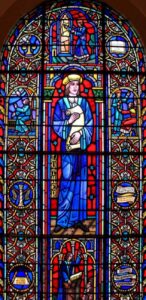
Installed in 1975, in memory of Mr. and Mrs. Raymond H. Aierstock. Designed by the Wilbur H. Burnham Studios of Wakefield, Massachusetts.
Luther, a Roman Catholic priest, following in the footsteps of Hus, in 1517 CE attacked the Popeʹs selling of indulgences (money gifts to seek forgiveness of sins and a guarantee of entrance into heaven) the proceeds of which financed the building of St. Peter’s Basilica in Rome. Excommunicated, he became a leader of a movement to reform the church, which today we call the Reformation. He was followed by Ulrich Zwingli and John Calvin and others, and so the Reformation spread quickly and widely in Germany, Switzerland and parts of France and Holland, and later into England and Scotland. He here is holding the 95 theses or questions concering the debate about indulgences which he nailed on the door of the church in Wittenberg, Germany on October 31, 1517 CE. The medallions on this window are, from lower left clockwise: 1) the thunder storm where he was converted: ʺHelp, beloved St. Anna! I will become a monk!ʺ; 2) his continuing penance – two whips and a pillar; 3) Luther at the Monastery at Erfurt – where he did his major writings; 4) hand of God holding the Scales of Justice; 5) nailing the 95 theses on the Wittenberg church door; 6) open Bible turned to Galatians 2:16: ʺwe are justified by faith in Jesus Christ, not by doing the works of the Lawʺ (RSV); 7) standing before the Emperor at the Diet (or council) of Worms in 1512 CE defending his reformed faith; 8) song book, with the words of his hymn, ʺEin feste Burg ist unser Gottʺ (A Mighty Fortress Is Our God!) 9) three scrolls symbolizing Lutherʹs three most important writings: ʺOn the Liberty of a Christian Manʺ, ʺAn Address to the Nobility of the German Nationʺ & ʺ On the Babylonian Captivity of the Church of Godʺ – each published in 1520 CE after he formally declared his independence from Rome.
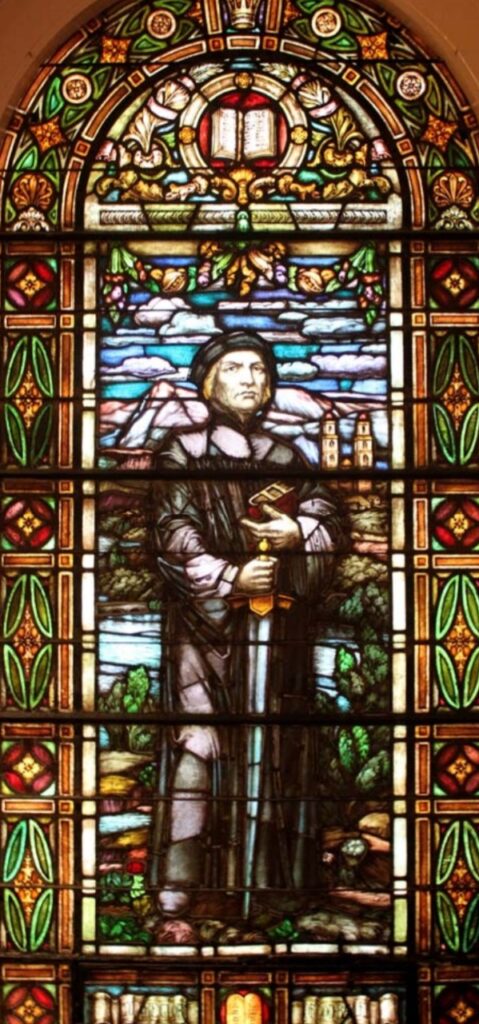
Installed in 1913, by Susan Hull and Mrs. Emma Bartlett, in memory of their parents. Designed by d’Ascenzo Studios, Philadelphia, Pennsylvania.
This window reflects the Swiss heritage within this congregation. Zwingli helped start the Reformation movement in Switzerland from his pastoral office at the Grossmünster, the twin steepled church pictured over his left shoulder. Graduated with a Masters in 1504 CE from the University of Zurich, he was ordained into the Roman priesthood in 1506 CE. By 1515 CE he was preaching against the purchasing of indulgences and the Popeʹs mercenary army. A surviving victim of the plague in 1520 CE in Zurich (which killed almost one/third of the population), he emerged from near-death a changed and energized man and began earnestly fighting for strict obedience to the literal teachings of scripture which Zwingli clutches in his left hand. In Switzerland, reform came through appeal to the cityʹs magistrate, who called for a debate between Roman Catholic theologians and the reformers. The reformers, who based their arguments solely on scripture, won the debate and were allowed to make needed reforms. Changes made included the abandoning of Lent, declaring clerical celibacy unbiblical, separating churches from the control of the Papacy and replacing the Mass with a preaching service and quarterly (rather than daily) communion. Unfortunately, although Zwingli and Luther agreed on 15 of the 16 key issues of the reformation, they could not agree on communion. Luther thought the elements were transformed into Christʹs body and blood (consubstantiation), and Zwingli believed communion was a more symbolic act. Luther called a halt to further fellowship because of this doctrinal difference. Both view points are to be found among members of the U.C.C. In 1531 CE, the Roman Catholic Church declared war against the Swiss Protestants. With an army of 5,000 against the Protestantsʹ 1,500, Zwingli, a soldier for Christ and defender of his country was killed at the Battle of Kappel in defense of Zurich.
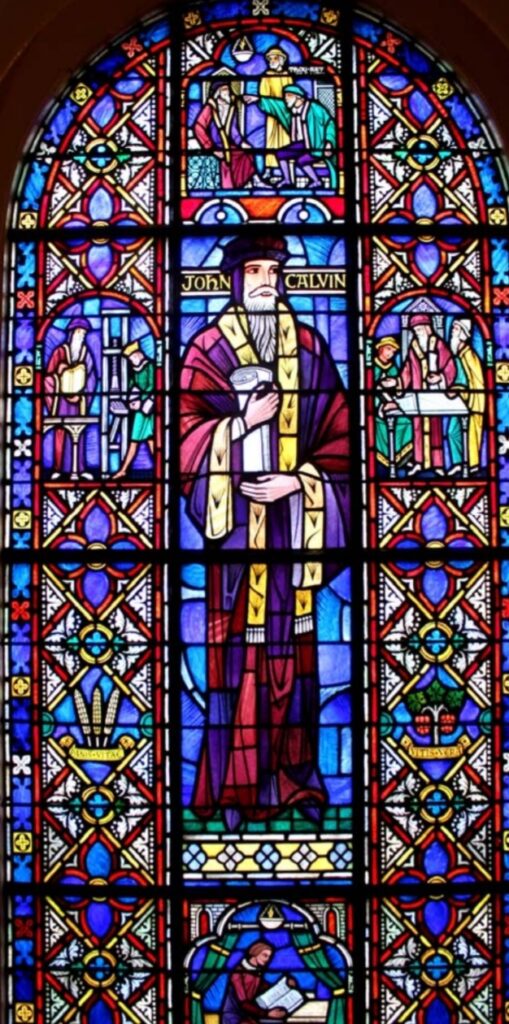
Installed in 1969, in memory of Mr. and Mrs. Fred Wiker. Designed by The Studios of Reynolds, Francis and Rohnstock, Boston, Massachusetts.
Trained as a humanist lawyer, John Calvin instead went into the priesthood, where his reforming views led him to break from the Roman Catholic Church in 1530. Forced from France by violent responses to his reformed thinking, he fled to Basel, Switzerland, where he published the first edition of his ʺInstitutes of the Christian Religionʺ in 1536 CE. In that year he was recruited by William Farel to help reform the church in Geneva. The city council resisted their efforts and expelled them. At the invitation of Martin Bucer, Calvin went to Strasborg, where he pastored a group of French refugees. Eventually invited back to lead the church in Geneva, he was opposed by several powerful families; but following an influx of supportive refugees and new elections, Calvinʹs opponents in the city council were forced out of leadership. He spent his final years promoting the Reformation both in Geneva and throughout Europe. Above Calvin, the medallion depicts his meeting with William Farel, with Farel saying, ʺYou are the man!ʺ The medallion to the left depicts the publishing of his ʺInstitutesʺ; and to the right his planning of the ʺIdeal Cityʺ. The medallion at the bottom shows Calvin in his study; and the Latin phrases at the lower left and right are ʺPanis-Vitae (Bread of Life) and ʺVitis-Vera (True Vine). Calvin taught that the presence of Christ in the Lord’s Supper was a spiritual presence in contrast to the views of both Martin Luther and Ulrich Zwingli.
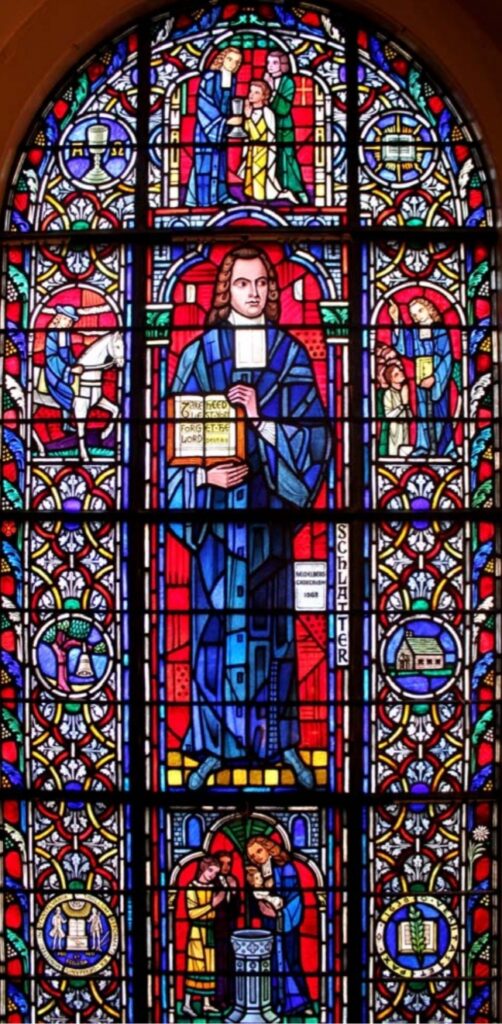
Installed in 1961, in memory of Paul E. Gutfliesch (1889-1958). Designed by The Studios of Reynolds, Francis and Rohnstock, Boston, Massachusetts.
Schlatter came to Pennsylvania in 1746 CE, commissioned by the German Reformed Church in Germany & Holland to organize Reformed Coetus/Synods in Virginia, Maryland and Pennsylvania, including our First Reformed. He pastored the church in Germantown and Philadelphia from 1746-51 CE. He first celebrated Holy Communion here on June 14, 1747 CE in our too small log church. Returning to Germany in 1751 CE to report on his work, he raised $20,000 in Holland and England to start free schools among the Germans in Pennsylvania, plus bringing 700 Bibles and six young preachers to work here. He returned to Philadelphia in 1752 CE, and in 1755 CE withdrew from pastoral ministries to become the superintendent of the new German schools. The schools were not well received among the Germans, so he resigned in 1757 CE to become an army chaplain. In 1777 CE, still attached to the royal army, he refused orders due to his sympathy for the colonists, was imprisoned and his home plundered. He was married to Maria Henrica Schleidorn of New York City, and they had nine children – six of whom survived them. Schlatter, robed, is holding an open Bible inscribed with the text of his first sermon in our log church: Deuteronomy 8:11 – ʺTake Heed lest you forget the Lordʺ. The symbols in the window, bottom left to right clockwise: l) seal of the Coetus/Synod; 2) the hickory tree and bell that called people to worship and community meetings and gave Lancaster it’s original name—”Hickorytown” 3) Schlatterʹs itinerate ministry by horseback; 4) pewter chalice inscribed with an Alpha and Omega – that the beginning of all things is in God; 5) offering the sacrament of holy communion to the settlers; 6) offering the sacrament of baptism; 7) our first log church on this site (1736) and 8) the open Bible from which he preached.

Memorial to Josiah H. Sheaffer (1835-1920). Given by Mary Elizabeth Sheaffer.
The Cherubs in our church are a far cry from a winged bull or similar mythological beasts adopted by the Israelites from Mesopotamian and Canaanite mythology. Leaders among the returning exiles from Babylonia were often called cherubs. The term sometimes referred to a city in Babylonia from which Jewish exiles with unclear genealogy came. Both of these cherubs are featured in “Sistine Madonna” an oil painting by the Italian artist Raphael– the last of the painterʹs Madonnas and the last painting he completed with his own hands. In the painting, the Madonna, holding the Christ Child and flanked by Saint Sixtus and Saint Barbara, stands on rising clouds while two distinctive winged cherubs rest on their elbows beneath her.

Memorial to Mrs. Ann Catharine Sheaffer (1842-1906). Given by Mary Elizabeth Sheaffer.
These prominent creatures in Raphael’s painting are famous
in their own right. As early as 1913 , one art critic declared
that ʺno cherub or group of cherubs is so famous as the two
that lean on the altar top (where the painting is displayed in
Dresden, Germany) indicated at the very bottom of the picture.ʺ Heavily marketed, they have been featured in stamps,
postcards, t-shirts, posters and wrapping paper.
In our windows in the choir loft, these angelic cherubs seem
more interested in observing those who are worshipping or
conducting business in the nave or the choir loft below. It is
left to your interpretation whether they approve of what they
see and hear!